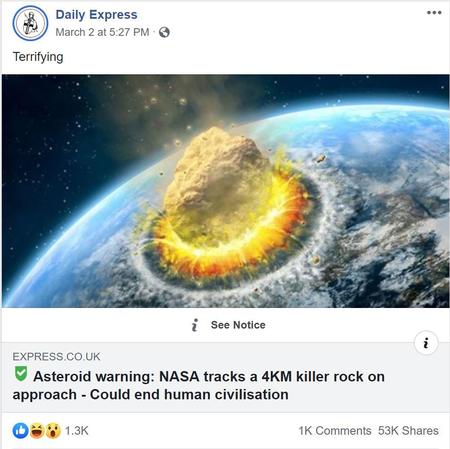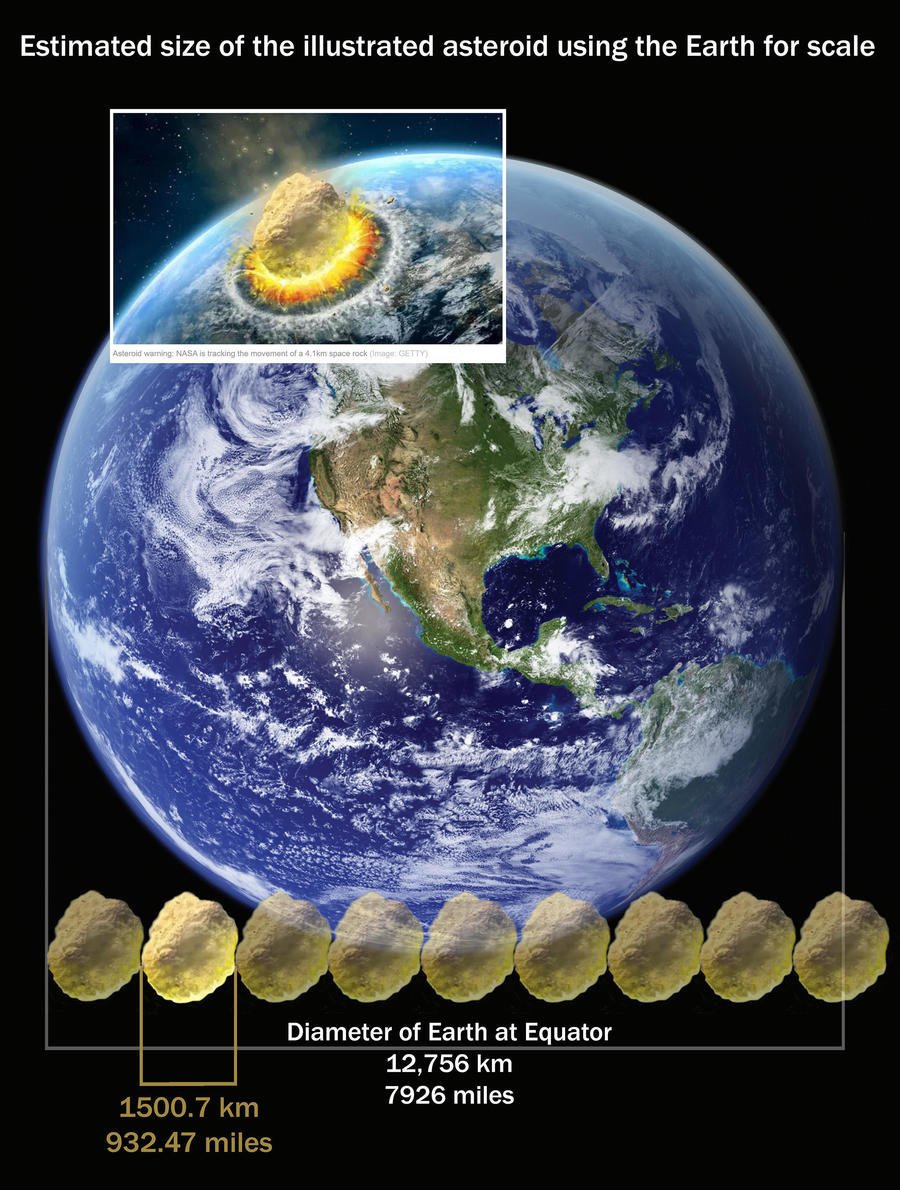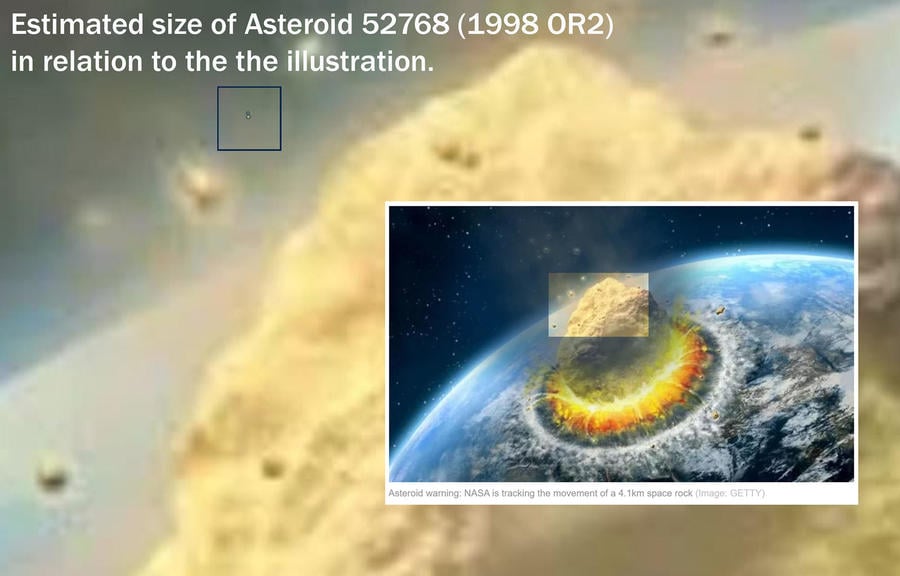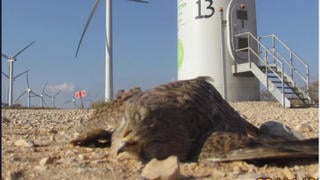STORY UPDATED: check for updates below.

Did NASA warn that a 4KM asteroid was approaching the Earth? No, that's not true, while NASA tracks many asteroids, this one poses no threat to our planet, and no warning has been issued. Lead Stories reached out to NASA, which confirmed that there is simply no danger - at all - of this asteroid impacting Earth, much like other asteroids and other space objects currently tracked by the space agency.
The claim originated from an article published by Daily Express on March 2, 2020, titled "Asteroid warning: NASA tracks a 4KM killer rock on approach - Could end human civilisation" (archived here) which opened:
AN ASTEROID capable of ending human civilisation if it hits will approach our planet in April, NASA's asteroid trackers have confirmed.
The asteroid is listed by NASA's Center for Near Earth Object Studies' (CNEOS) in California, US. The asteroid has been officially called 52768 (1998 OR2) and is estimated measure up 2.5 miles (4.1km) across.
An object this big could potentially kill millions of people if it ever hit the planet in the distant future.
NASA estimates the rock is heading our way at speeds of about 8.7km per second or 19,461mph (31,320kmh).
At this rate, the asteroid will close-in on Earth on April 29.
When this happens, NASA said the asteroid will make a "close approach" to our planet.
According to the Planetary Society, an asteroid bigger than 0.6 miles (1km) across is big enough to threaten global destruction.
Users on social media only saw this title, description and thumbnail:
Asteroid warning: NASA tracks a 4KM killer rock on approach - Could end human civilisation
AN ASTEROID capable of ending human civilisation if it hits will approach our planet in April, NASA's asteroid trackers have confirmed.
The Daily Express shared the article on their Facebook page here on March 2, 2020, with a caption that only read, "Terrifying." In just four days, between four tweets of the story spread across several days, the post had gathered 53,000 shares on Facebook. The @Daily_Express twitter account had accumulated about 137,000 reactions, including 32,317 retweets.
Lead Stories reached out to Dr. Paul W. Chodas, the Director at NASA's Center for Near Earth Object Studies (CENOS), for comment. He replied:
Yes, these articles are problematic: They are completely misleading because they imply there is a chance that these asteroids can impact the Earth. They misrepresent the results from CNEOS.
CNEOS tracks all the near-Earth asteroids, and we publish predictions of close approaches to Earth here: https://cneos.jpl.nasa.gov/ca/
The article correctly points out that 1998 OR2 will approach Earth to 16.36 Lunar Distances (LD), or about 6.3 million km, on April 29. They get that number from our table, and we get that number from our calculations of the asteroid orbit. We have been tracking this asteroid for decades, and we have lots of data! But, there is no chance at all that this asteroid or any other on the table can impact!
This should be clear from the column "labeled CA Distance Minimum" which clearly states that the minimum possible close approach distance is the same: 16.36 LD: we know that it can't get any closer, even including all the uncertainties in the calculations! We don't "Issue a Warning" because there is no hazard whatsoever: Again, there is ZERO chance of an impact.
Through the Planetary Defense Coordination Office, NASA has a clear protocol for when an actual warning is warranted and how that is to be carried out.
Daily Express regularly publishes warnings about asteroids. The articles are filled with factual details pulled from NASA's publicly available tables - and then lots of conjecture is added to produce alarming headlines. Another recent article (archived here), titled, 'Asteroid warning: NASA tracks a 'potentially hazardous' rock rapidly approaching Earth,' opened by saying:
AN ASTEROID dubbed "potentially hazardous" and measuring up to 1,280ft (390m) across, is headed our way at more than 52,900mph (85,130kmh), US space agency NASA has found."
The asteroid has been named 2012 XA133 and is flying our way on a "close approach" trajectory. At its current speed, NASA estimates the space rock will close-in on us before the end of March."
What did Chodas have to say about that?
Furthermore, all the close approaches on our table have ZERO chance of impacting, including 2012 XA133.
Referring to the article about Asteroid 52768 (1998 OR2), Chodas said:
This article is mostly false, because its main point is to suggest there's a danger when there is absolutely no danger.
We have another webpage where we list all asteroids that DO have a chance of impacting Earth: https://cneos.jpl.nasa.gov/sentry/
In other words, if an asteroid has a chance of impacting, it will be on this page, not the other.
Encounters on the Sentry page all have very small probabilities, most of those encounters are decades away, and 90% of the asteroids are so small that they would burn up in the atmosphere. Furthermore, as we track those objects, we expect that our prediction accuracy will improve to the point that we rule out most if not all of the potential impacts on this list.
The Center for Near Earth Object Studies sent out a tweet regarding this article.
On April 29. asteroid 1998 OR2 will safely pass Earth by 3.9 million miles/6.2 million km. A @Daily_Express article implying there is a "warning" about this asteroid is false. A complete listing of all asteroid passes is always public at https://t.co/i6i8HwCDJq. Carry on!
-- Asteroid Watch (@AsteroidWatch) March 4, 2020
The article contains several sci-fi art images. The featured digital illustration by Andrea Danti titled, "Big asteroid crashing on the surface of an Earth-like planet", depicts an imaginary fiery impact. This image is widely available as a stock image. It seems clear that the artist had no intention to accurately illustrate - or misrepresent - this specific scenario. By using the picture, the image's impact becomes at least as strong as the misleading headline.
Does the illustration happen to show a space rock the 4.1 km size of the 52768 (1998 OR2) asteroid?
The Earth's curvature in the illustration was scaled and matched to an image of Earth sourced from NASA. We can now compare the size of the imaginary space rock to Earth's diameter.
 The illustrated space rock is estimated to be about 1,500 km across (or 932 miles). Using Photoshop, we scaled the rock in the illustration to be 3,000 pixels wide. Then, we could measure, pixel by pixel, to depict the approximate size of the real asteroid in relation to the one in the illustration. There are two tiny dots included inside the dark square, and they represent the smaller and larger limits of the estimated size (1.5- 4.1 km) of the 52768 (1998 OR2) asteroid.
The illustrated space rock is estimated to be about 1,500 km across (or 932 miles). Using Photoshop, we scaled the rock in the illustration to be 3,000 pixels wide. Then, we could measure, pixel by pixel, to depict the approximate size of the real asteroid in relation to the one in the illustration. There are two tiny dots included inside the dark square, and they represent the smaller and larger limits of the estimated size (1.5- 4.1 km) of the 52768 (1998 OR2) asteroid.
When April 29, 2020, rolls around, the asteroid will pass our planet at a distance of about 6.3 million km (3.9 million miles). Astronomers give the distance that the 52768 (1998 OR2) asteroid will pass as 16.36 LD or 0.04205 au. Lunar Distance (LD) represents the average distance from the center of the Earth to the center of the moon, and that's 384,400 km (or 238,855 miles). An astronomical unit (au) is the average distance from Earth to the Sun, that's 150 million km (or 93 million miles). That means on April 29, 2020, the asteroid will be more than 16 times further from Earth than the Moon.
If we scaled this down to a model on a map of the United States, put the Earth at New York City and the Moon at Harrisburg, Pennsylvania- 16.36 times that distance would take us across the country to Los Angeles.
Here is a sampling of asteroid headlines collected from Daily Express:
NASA asteroid warning: 'Nothing' can be done to stop major asteroid destroying Earth (here)
Asteroid warning: NASA tracks a 1KM rock that could kill millions on rapid Earth approach (here)
Asteroid warning: NASA radars predict slim chance of impact with 600M rock - Will it hit? (here)
Asteroid warning: NASA tracks a 'potentially hazardous' rock rapidly approaching Earth (here)
Asteroid warning: NASA reveals shocking odds of asteroid ending life on Earth (here)
Asteroid WARNING: Asteroid Apophis 'headed right for Earth' could hit on Friday 13, 2029 (here)
Asteroid warning: Millions of 'nuclear bomb-like' asteroids threaten Earth (here)
Asteroid warning: NASA tracks a killer rock approach tomorrow - Could wipe out a continent (here)
Asteroid warning: Major asteroid collision could be CATASTROPHIC - NASA warning (here)
Asteroid warning: 'Little we can do' Expert admits Earth defenceless to space rock (here)
Asteroid warning: Russian space agency reveals chances of major asteroid hitting Earth (here)
Asteroid warning: Astronomers find asteroids once thought harmless can still strike Earth (here)
Asteroid alert: NASA tracks a rock found FIVE days ago on a 34,000MPH Earth approach today (here)
Asteroid alert: NASA tracks a large rock heading past Earth at 43,500mph - Will it hit? (here)
Asteroid alert: NASA tracks four large space rocks racing towards Earth in next 48 hours (here)
NASA asteroid alert: A large asteroid just shot past Earth at 33,000MPH (here)
NASA asteroid alert: Radars track a 20,000MPH space rock on 'close approach' this weekend (here)
Asteroid alert: NASA warns of FIRESTORMS and tsunamis as 1KM rock approaches Earth (here)
Asteroid alert: NASA spots a 48,400MPH asteroid barreling towards us on a 'close approach' (here)
Asteroid alert: A 47,500MPH asteroid will approach Earth tomorrow - But will it hit us? (here)
Asteroid alert: NASA tracks an asteroid taller than Big Ben on 'approach' - Will it hit? (here)
Asteroid alert: A 100M asteroid is heading towards us days after discovery - Will it hit? (here)
Asteroid alert: NASA tracks a 656FT rock heading towards Earth this week - Will it hit? (here)
NASA asteroid alert: Scientists give exact date rock size of Great Pyramid could hit Earth (here)
NASA asteroid DANGER: A 2,700 MEGATON asteroid might hit Earth this October (here)
NASA asteroid horror: Radars track potential impact date in May 2022 with 230 kiloton rock (here)
Asteroid alert: NASA spots a 21,100MPH space rock heading towards Earth - Will it hit? (here)
Asteroid shock: NASA breaks silence as killer asteroid approaches Earth TODAY (here)
Asteroid approach: NASA tracks a 18,500MPH asteroid headed our way tomorrow - Will it hit? (here)
Asteroid tsunami: US coast warning as Atlantic-bound rock 'will send 100m waves' revealed (here)
Asteroid news: Is there an asteroid heading for Earth? Has NASA found something in 2019? (here)
Asteroid Apophis: Will 1,200ft asteroid named after god of CHAOS slam into Earth in 2020? (here)
Asteroid shock: 'Significant chance' asteroid will hit Earth expert warns (here)
Asteroid will DEFINITELY hit Earth and could wipe out London, expert warns (here)
Asteroid terror: Fears of carnage as monster rock to pass Earth at 17,000mph on Tuesday (here)
IMPACT of asteroid that will approach Earth in 2029 'CANNOT be ruled out' (here)
Asteroid news: NASA tracks a 64,700MPH space rock on Earth 'approach' - Will it hit? (here)
Asteroid fears: Scientist claimed apocalyptic rock WILL hit Earth - 'Need to do something' (here)
Asteroid MISS: An asteroid bigger than a bus just shot past Earth as far as the Moon (here)
Asteroid bombshell: NASA reveals probability of 'extinction event' rock hitting Earth (here)
Asteroid impact: Asteroid Bennu COULD collide with Earth warns expert (here)
Asteroid danger: '100% chance of impact' space expert alerts in 'life or death' warning (here)
Worry not. None of these asteroid warnings were followed by civilization-destroying impacts.
Updates:
-
2020-03-11T15:38:59Z 2020-03-11T15:38:59Z On March 11, 2020 Daily Express published a new story titled "Asteroid alert: NASA is tracking a 21,000MPH asteroid approaching Earth - Will it hit us?" again implying imminent danger by the use of the word "Alert". This story is misleading for the exact same reasons listed above.















